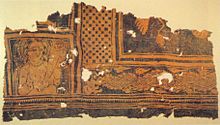Cadota 尼雅 | |
 Textile from Niya, showing influences from the East and the West. | |
| Location | Xinjiang, China |
|---|---|
| Coordinates | 38°01′17″N 82°44′15″E / 38.021400°N 82.737600°E |
| Type | Settlement |
| History | |
| Abandoned | 4th to 5th century[1] |
| Site notes | |
| Condition | In ruins |
The Niya ruins (simplified Chinese: 尼雅遗址; traditional Chinese: 尼雅遺址; pinyin: Níyǎ Yízhǐ), is an archaeological site located about 115 km (71 mi) north of modern Niya Town on the southern edge of the Tarim Basin in modern-day Xinjiang, China. The ancient site was known in its native language as Caḍ́ota[citation needed], and in Chinese during the Han dynasty as Jingjue (Chinese: 精絕; pinyin: Jīngjué, Old Chinese tseng-dzot, similar to Caḍ́ota[citation needed]). Numerous ancient archaeological artifacts have been uncovered at the site.
Niya was once a major commercial center on an oasis on the southern branch of the Silk Road in the southern Taklamakan Desert. During ancient times camel caravans would cut through, carrying goods from China to Central Asia.[2][3]
- ^ Tang, Ye-Na; Li, Xiao; Yao, Yi-Feng; Ferguson, David Kay; Li, Cheng-Sen (2014-01-27). "Environmental Reconstruction of Tuyoq in the Fifth Century and Its Bearing on Buddhism in Turpan, Xinjiang, China". PLoS ONE. 9 (1): e86363. doi:10.1371/journal.pone.0086363. ISSN 1932-6203. PMC 3903531. PMID 24475109.
- ^ Cite error: The named reference
silkmonkswas invoked but never defined (see the help page). - ^ "The Most Important Findings of Niya in Taklamakan". The Silk Road. Retrieved 2007-07-21.
